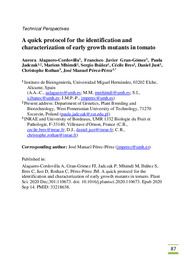Título :
A quick protocol for the identification and characterization of early growth mutants in tomato |
Autor :
Alaguero Cordovilla, Aurora
Gran Gómez, Francisco Javier
Jadczak, Paula 
Mhimdi, Mariem 
Ibáñez, Sergio
BRES, CECILE 
Just, Daniel
ROTHAN, Christophe 
Pérez Pérez, José Manuel |
Editor :
Elsevier |
Departamento:
Departamentos de la UMH::Biología Aplicada |
Fecha de publicación:
2020-12 |
URI :
https://hdl.handle.net/11000/35298 |
Resumen :
Root system architecture (RSA) manipulation may improve water and nutrient capture by plants under normal and extreme climate conditions. With the aim of initiating the genetic dissection of RSA in tomato, we established a defined ontology that allowed the curated annotation of the observed phenotypes on 12 traits at four consecutive growth stages. In addition, we established a quick approach for the molecular identification of the mutations associated with the trait-of-interest by using a whole-genome sequencing approach that does not require the building of an additional mapping population. As a proof-of-concept, we screened 4543 seedlings from 300 tomato M3 lines (Solanum lycopersicum L. cv. Micro-Tom) generated by chemical mutagenesis with ethyl methanesulfonate. We studied the growth and early development of both the root system (primary and lateral roots) and the aerial part of the seedlings as well as the wound-induced adventitious roots emerging from the hypocotyl. We identified 659 individuals (belonging to 203 M3 lines) whose early seedling and RSA phenotypes differed from those of their reference background. We confirmed the genetic segregation of the mutant phenotypes affecting primary root length, seedling viability and early RSA in 31 M4 families derived from 15 M3 lines selected in our screen. Finally, we identified a missense mutation in the SlCESA3 gene causing a seedling-lethal phenotype with short roots. Our results validated the experimental approach used for the identification of tomato mutants during early growth, which will allow the molecular identification of the genes involved.
|
Palabras clave/Materias:
Solanum lycopersicum
Micro-Tom
EMS mutagenesis
Root system architecture (RSA)
Plant phenotyping
Whole-genome sequencing |
Área de conocimiento :
CDU: Ciencias puras y naturales: Biología |
Tipo de documento :
info:eu-repo/semantics/article |
Derechos de acceso:
info:eu-repo/semantics/openAccess
Attribution-NonCommercial-NoDerivatives 4.0 Internacional |
Publicado en:
Plant Science
Volume 301, December 2020, 110673 |
Aparece en las colecciones:
Artículos - Biología Aplicada
|
 La licencia se describe como: Atribución-NonComercial-NoDerivada 4.0 Internacional.
La licencia se describe como: Atribución-NonComercial-NoDerivada 4.0 Internacional.
.png)
